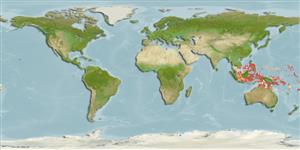>
Gobiiformes (Gobies) >
Gobiidae (Gobies) > Gobiinae
Etymology: Eviota: No etymology given, suggested by Christopher Scharpt: from Latin 'eu' for 'true' and 'iota' for anything very small, in combination 'truly very small' referring to it as being the smallest vertebrate at the time it has benn described by Jenkins (thus, making the suggestion by Scharpt plausible.; pellucida: Name from Latin 'atrus' for black and 'venter' for belly, referring to the black pigment in the area of the abdomen; an adjective..
More on author: Larson.
Environment: milieu / climate zone / depth range / distribution range
Écologie
marin récifal; profondeur 3 - 30 m (Ref. 46956). Tropical; 22°C - 25°C (Ref. 27115); 14°N - 18°S
Western Pacific: Japan (Ryukyu Islands), Micronesia (Pohnpei, Guam, Marshall Islands, and Kiribati (Abaiang Atoll). Other country records represent Eviota atriventris.
Taille / Poids / Âge
Maturity: Lm ? range ? - ? cm
Max length : 2.1 cm SL mâle / non sexé; (Ref. 46956)
Description synthétique
Clés d'identification | Morphologie | Morphométrie
Épines dorsales (Total) : 7; Rayons mous dorsaux (Total) : 8; Épines anales: 1; Rayons mous anaux: 7. This species belongs to the cephalic sensory-pore group 2 with the following characters: lacking only the IT pore, has simple pectoral-fin rays, a dorsal/anal fin-ray formula almost always 8/7, and with the 5th pelvic-fin ray longer than 30% of the length of the 4th ray; however, its abdomen is not black. It is most easily confused with E. prasites and E. spilota (Ref. 89418).
Collected from 3m to at least 12 m depth (Ref. 1602). Reported to be associated with the mushroom Heliofungia actiniformis (Ref. 91291).
Life cycle and mating behavior
Maturities | Reproduction | Spawnings | Egg(s) | Fecundities | Larves
Larson, H.K., 1976. A new species of Eviota with discussion of the nominal genera Eviota and Eviotops. Copeia 1976(3):498-502. (Ref. 46956)
Statut dans la liste rouge de l'IUCN (Ref. 130435)
Menace pour l'homme
Harmless
Utilisations par l'homme
Pêcheries: commercial; Aquarium: Commercial
Outils
Articles particuliers
Télécharger en XML
Sources Internet
Estimates based on models
Preferred temperature (Ref.
123201): 27.4 - 29.3, mean 28.8 °C (based on 1334 cells).
Phylogenetic diversity index (Ref.
82804): PD
50 = 0.5000 [Uniqueness, from 0.5 = low to 2.0 = high].
Bayesian length-weight: a=0.01023 (0.00477 - 0.02194), b=3.02 (2.84 - 3.20), in cm total length, based on LWR estimates for this (Sub)family-body shape (Ref.
93245).
Niveau trophique (Ref.
69278): 3.1 ±0.3 se; based on size and trophs of closest relatives
Résilience (Ref.
120179): Haut, temps minimum de doublement de population inférieur à 15 mois (Preliminary K or Fecundity.).
Fishing Vulnerability (Ref.
59153): Low vulnerability (10 of 100).
Nutrients (Ref.
124155): Calcium = 403 [172, 1,398] mg/100g; Iron = 1.87 [0.79, 4.22] mg/100g; Protein = 18 [16, 20] %; Omega3 = 0.169 [0.052, 0.536] g/100g; Selenium = 33.4 [9.8, 96.6] μg/100g; VitaminA = 116 [22, 599] μg/100g; Zinc = 4.97 [2.63, 8.48] mg/100g (wet weight);
